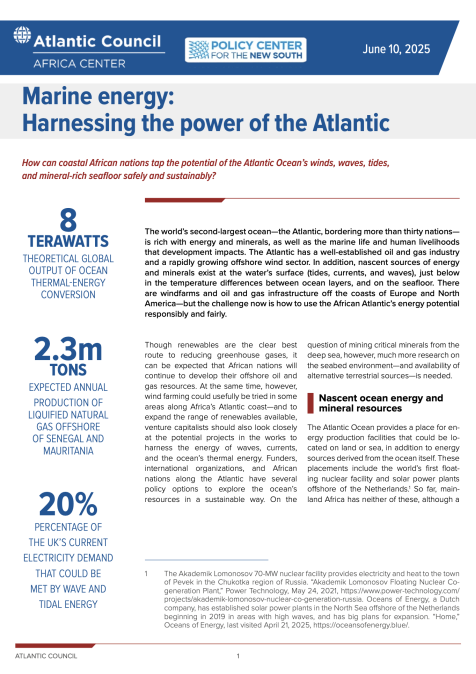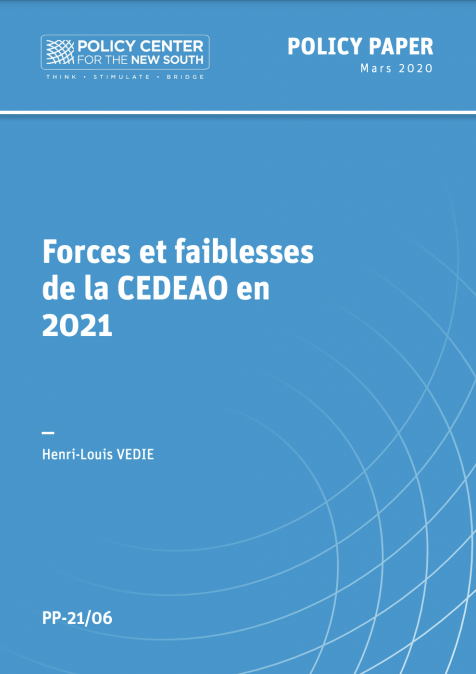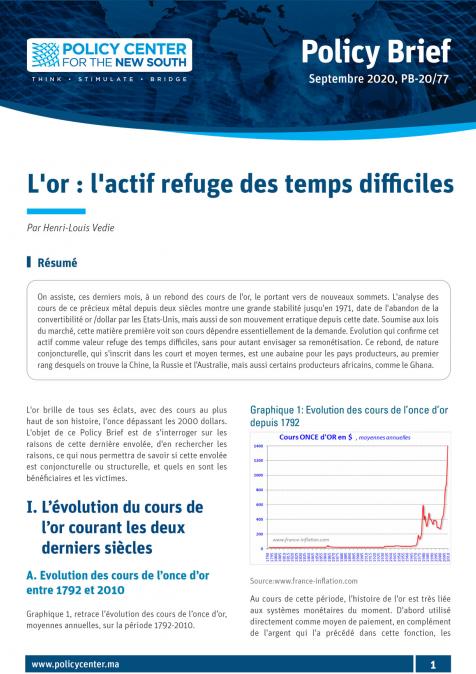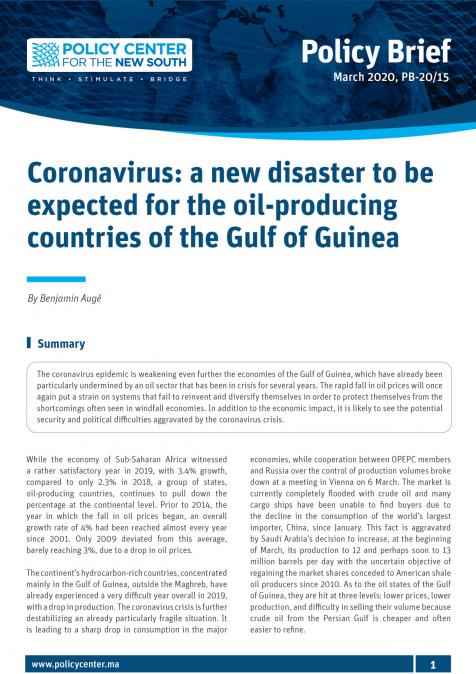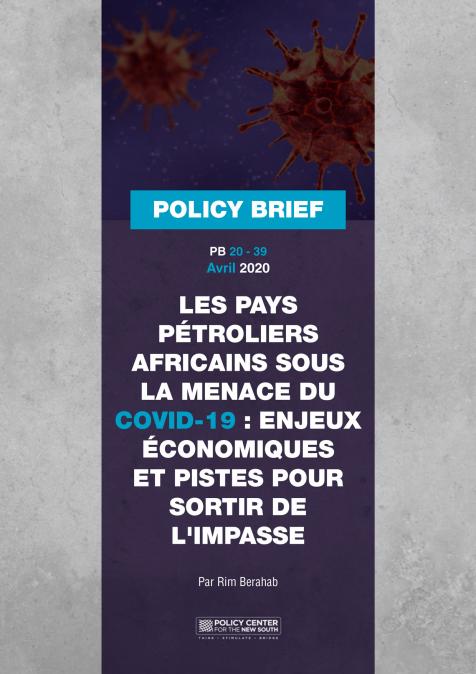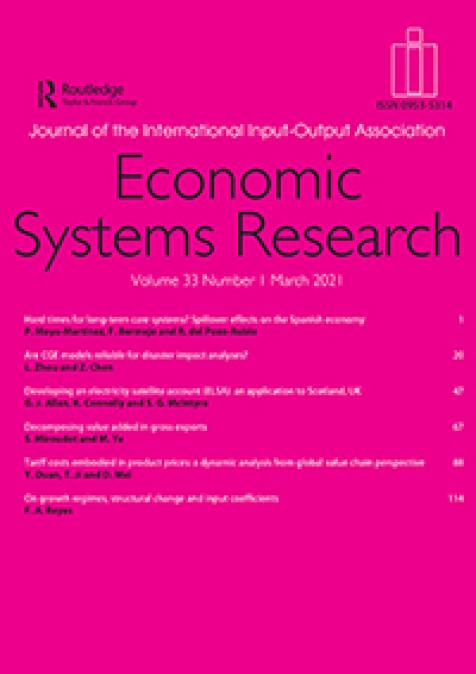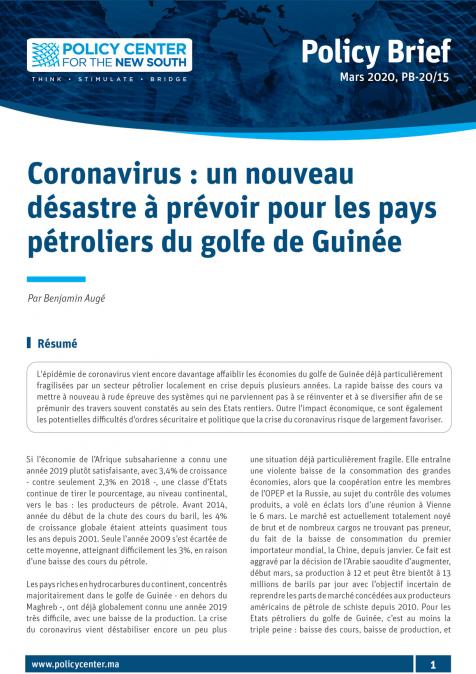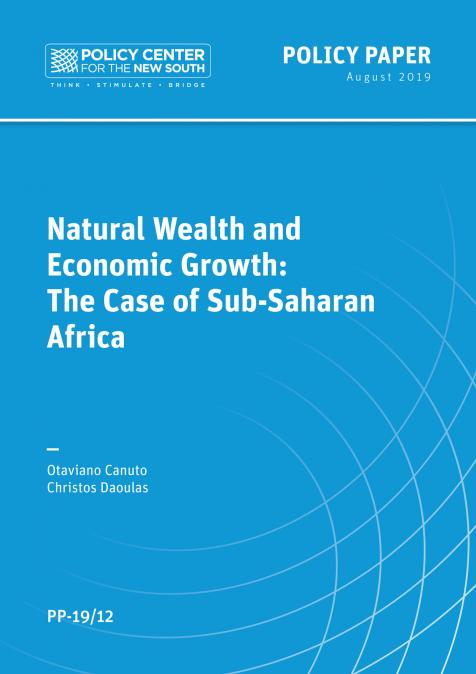Publications /
Policy Brief
This Paper was originally published on atlanticcouncil.org
Following a decade-long partnership, the Policy Center for the New South and the Atlantic Council have joined forces around a new program focused on the power of the Atlantic. This series of publications and webinars will focus both on opportunities and challenges around the basin.
This brief, the inaugural of the series, by William Yancey Brown highlights the vast energy and mineral potential of the Atlantic Ocean and how African nations bordering the basin can manage resources responsibly and fairly. It launches against a backdrop that includes World Ocean Day, the 2025 UN Ocean Conference, and the continuing work of the Group of Twenty (under South Africa’s presidency) within the Oceans 20 engagement group.
The Atlantic Ocean is of paramount importance to Africa. The African nations on the ocean’s shore represent 46 percent of the continent’s population, 55 percent of its gross domestic product, and 57 percent its trade. The blue economy is crucial for Africa as the continent’s economies see new changes brought upon by issues related to the maritime energy transition, the port revolution, maritime transport, fishing, and control over exclusive economic zones. African countries have accordingly developed frameworks, through the African Union, for action in the region and declared 2015-2025 the “Decade of Africa’s Seas and Oceans.”
Introduction
The world’s second-largest ocean—the Atlantic, bordering more than thirty nations—is rich with energy and minerals, as well as the marine life and human livelihoods that development impacts. The Atlantic has a well-established oil and gas industry and a rapidly growing offshore wind sector. In addition, nascent sources of energy and minerals exist at the water’s surface (tides, currents, and waves), just below in the temperature differences between ocean layers, and on the seafloor. There are windfarms and oil and gas infrastructure off the coasts of Europe and North America—but the challenge now is how to tap the African Atlantic’s energy potential responsibly and fairly.
Though renewables are the clear best route to reducing greenhouse gases, it can be expected that African nations will continue to develop their offshore oil and gas resources. At the same time, however, wind farming could usefully be tried in some areas along Africa’s Atlantic coast—and to expand the range of renewables available, venture capitalists should also look closely at the potential projects in the works to harness the energy of waves, currents, and the ocean’s thermal energy. Funders, international organizations, and African nations along the Atlantic have several policy options to explore the ocean’s resources in a sustainable way. On the question of mining critical minerals from the deep sea, however, much more research on the seabed environment—and availability of alternative terrestrial sources—is needed.
Nascent ocean energy and mineral resources
The Atlantic Ocean provides a place for energy production facilities that could be located on land or sea, in addition to energy sources derived from the ocean itself. These placements include the world’s first floating nuclear facility and solar power plants offshore of the Netherlands.1 So far, mainland Africa has neither of these, although a floating solar power plant is planned for the Seychelles.2 Ocean locations present a harsh environment for devices and accessibility, and environmental restoration is difficult if accidents occur. On the other hand, ocean placement offers space and distance from human settlements.
Tides and currents. Moving river water made up about 15 percent of global electricity generation in 2023.3Hydropower makes up more than half of electricity generated in the Democratic Republic of Congo, Brazil, and Norway.4 The Atlantic Ocean has its own standing currents and tidal flows, such as the Gulf Stream and the Atlantic Meridional Overturning Circulation, and powerful tides in locations on both coasts of the basin.
Small-scale generating facilities powered by non-tidal, standing ocean currents have been tested in locations including the Gulf Stream offshore of the United States and the Kuroshio Current offshore of Japan, but no commercial-scale facility is operating anywhere yet.5 The greatest potential for non-tidal current power in the African Atlantic is reportedly offshore of South Africa, or perhaps of Guinea-Bissau and Morocco.6
A 240-megawatt (MW) tidal power plant has operated on the Atlantic coast of France since 1966.7 Africa has some much smaller Atlantic tidal plants, but no commercial-scale tidal power generating facilities are operating there and prospects for tidal facilities offshore of Africa’s Atlantic coast are weak.8 Cost is a principal impediment. Environmental impacts are also a concern, but the same is true for well-developed hydropower on land. Despite tepid progress to date for tidal power, new projects are on the books in Europe.9
Waves. Waves offer great potential power for electricity on Atlantic coasts. Wave action on the US Atlantic coast could reportedly provide average power generation of about 18 gigawatts (GW).10 Wave and tidal current energy could potentially meet up to 20 percent of the United Kingdom’s current electricity demand.11 Atlantic Africa has energetic waves in the south offshore of South Africa and, to a lesser extent, Namibia. Senegal, Cabo Verde, and Morocco in the north also have high wave potential.12
Many wave energy test projects have been completed or proposed for the Atlantic in the United States, United Kingdom, and Europe.13 However, only one small wave energy facility offshore of northern Portugal currently provides electricity to the grid.14 Another small grid-linked project off a pier is set to begin operations in 2025 in Los Angeles.15 As for tides and currents, the challenge and cost of maintaining wave energy facilities remains an impediment to significant deployment.
Ocean thermal energy conversion. Tropical seas, including in the Atlantic, have surface waters much warmer than the deep sea. This difference allows devices to circulate water and power turbines through ocean thermal energy conversion (OTEC).16 “Open” versions of the technology can also desalinate seawater. OTEC could theoretically provide about 8 terawatts (TW) of power globally, more than the current global electricity demand.17 However, OTEC has a long history of experimentation without yet providing a commercial operating source of power to the grid.18 This might change with a small 1.5-MW project scheduled to be installed in 2025 offshore of São Tomé and Príncipe.19 There is also potential for floating OTEC along the west coast of continental Africa, with the highest potential reportedly from Guinea to Gabon.20
Methane hydrates. Methane hydrates are ice-like solids in which water traps methane. They occur on ocean continental margins, including offshore of the Americas and Africa, and hold vast amounts of carbon and energy.21 Combined with this promise is the peril of releasing methane from any mining, including through submarine landslides. Japan has taken a special interest in methane hydrates and has conducted experimental projects successfully extracting methane gas.22 No such projects have yet been undertaken in the Atlantic Ocean.
Developed ocean energy and mineral resources
Oil and gas. Under its Stated Policies Scenario (STEPS), the International Energy Agency (IEA) estimates that global oil supply will decrease about 7 percent by 2050 and natural gas production will increase by about 4 percent.23 Offshore production currently comprises roughly 30 percent of global oil supply and 28 percent of global natural gas production.24 Large historical Atlantic-linked sources include the Gulf of Mexico and the North Sea.
Rystad Energy estimates that, in Africa, about 3.5 million barrels of oil equivalent per day (boepd) of new deepwater oil and gas supply will be near final decision or under construction by 2035. Nigeria is the historic hub of West African offshore oil production and expects to raise production from 2 million barrels per day (bpd) to 3 million bpd with an anti-theft initiative.25 The Baleine Field offshore of Cote d’Ivoire and Namibia’s offshore Orange Basin recently began production, and exploration is under way or planned offshore of São Tomé & Principe, Liberia, and Sierra Leone, among other countries.26 Natural gas production began in January 2025 offshore of Senegal and Mauritania and is expected to produce around 2.3 million tons of liquified natural gas (LNG) annually for more than twenty years.27 Brazil’s state-owned oil company Petrobras predicts a ramping up of current offshore production to 3.2 million barrels per day (equivalent; including natural gas) in the next five years, with oil production centered on its “pre-salt” basins.28 Guyana’s Stabroek Block expects to produce 1.3 million bpd of oil by 2027 and holds an estimated 11.6 billion barrels of recoverable oil and significant natural gas.29
Wind energy. Offshore wind energy farms globally provided an estimated 75 GW installed operating capacity as of 2023, about 7.5 percent of the roughly 1,000 GW total installed global wind energy that year.30 Europe and the United Kingdom have historically led offshore wind development, but China is now leading deployment.31
Atlantic Ocean wind farms are currently operating offshore of the United Kingdom, Europe, and the northeastern and mid-Atlantic coast of the United States, with additional farms planned.32 Three commercial offshore wind farms are now operating in the United States, with other US Atlantic projects under construction.33 The US Atlantic projects are driven by coastal state governments that have established targets for renewable energy. However, supply chain issues and costs have led to the cancellation of some proposed projects. Development is also weighed down by the shift from the strong support of the Biden administration to adversity from the Trump administration.34
No wind farms are currently operating offshore of South America or Africa. Planning is under way but in early stages for Brazil, Morocco, and South Africa. Africa has good winds for turbines on the Atlantic coast in the south and northwest.35 Locations on either side of the Cape of Good Hope are being considered in South Africa, with a specific project proposed to the east in Richards Bay.36
Critical minerals in the Atlantic
Critical minerals are generally defined by national laws as minerals that are essential for important industries and vulnerable to supply chain disruption.37
Most critical minerals, including rare earths, are more scarce than rare in terms of the amounts present in geologic features found at many locations around the globe. However, their actual mining and production are constrained, with China producing most critical minerals and Africa a key place for mining. For example, 74 percent of the world’s cobalt is mined in the Democratic Republic of Congo (DRC), under conditions that are both unsafe and undependable.38 Dependable access to critical minerals without overreliance on China is a priority for many Western industries. The United States was a leader in the past but, despite such high interest in critical minerals, global prices for key metals and material fell by about 26 percent in 2023, including a 47-percent decline in cobalt and a 32-percent decline in lithium carbonate.39
Whether these minerals should be mined from the deep seabed beyond national jurisdiction, in addition to land mining, is hotly debated under international law (see below). Polymetallic nodules (PMNs) in the Clarion-Clipperton Zone in the Pacific Ocean, where these nodules are abundant, receive the most attention from industry, governments, and nongovernmental organizations. The International Seabed Authority (ISA) has designated Atlantic Ocean exploration areas for polymetallic sulfides (PMSs) along the mid-Atlantic Ridge and for cobalt-rich ferromanganese crusts (FMCs) in the South Atlantic.40 Little information is publicly available about potentially recoverable amounts and no exploitation has been authorized, but research on the biological communities that could be impacted raises great concerns for environmental impacts.41 The Trump administration stepped outside of the ISA in April 2025 with an executive order promoting seabed mining both on the high seas and the US continental shelf.42 Encouraged by the order, Canada’s The Metals Company has announced that it will apply for permission to mine high-seas PMNs under a US statute,43 despite protests from the ISA,44 and another company, California-based Impossible Metals, has applied to mine PMNs in the US territory of American Samoa.45 The Department of Interior announced on May 20 that it was launching the process for a lease sale there based on that application.46
The environmental framework
The ocean energy sources described above are primarily regulated by the nations to which they are adjacent, either because the resources are located in sedimentary geologic formations of the continental shelf (as in the case of oil) or because proximity to onshore populations facilitates construction and operations and lessens the cost of transmitting electricity (as in the case of wind). Critical mineral exploration and mining are primarily regulated on the continental shelves of nations under national laws and on the high seas by the ISA, which was established under the United Nations Convention on Law of the Sea (UNCLOS).47The United States also has a dated statute for high seas mining, applicable to anyone under US jurisdiction.48
National laws for ocean energy and mineral development vary, and this short paper cannot document their details. But consider US laws for reference. The facilities involved require authorization from the Bureau of Ocean Energy Management (BOEM) under the Outer Continental Shelf Lands Act (OCSLA).49 Authorization begins with leasing, followed by approval of development plans, with environmental review under the National Environmental Policy Act (NEPA).50 NEPA is a procedural statute without ultimate environmental standards. The approvals include conditions, most designed to mitigate environmental impacts, whose authorities come from other US environmental laws. A large offshore wind farm might have one hundred conditions. OCSLA includes standards to minimize environmental harm, but environmental review is given sharper teeth through the Endangered Species Act (ESA) and the Marine Mammal Protection Act (MMPA), which have firm impact tests.51 Noise is a significant concern, and is regulated as “harassment” under the ESA and MMPA. OCSLA also requires lessees to decommission facilities at their expense once a lease ends. All of these regulatory actions are subject to judicial review and many rulings have affected requirements. That said, oil, gas, and wind energy projects have gotten through the approval process and are operating in the United States.
European nations with Atlantic coasts (and the EU itself), South American nations, and some African nations have legal frameworks for environmental review with environmental assessment procedures akin to those of NEPA in the United States. Most lack hard stops such as the ESA and MMPA. Article 6(4) of the EU Habitat Directive approaches these stops, requiring that certain actions with negative environmental impacts can proceed only if carried out for “imperative reasons of overriding public interest” and with compensatory measures.52 The International Offshore Petroleum Environmental Regulators (IOPER) provides a venue for cooperation on oil and gas environmental regulation in the Atlantic and elsewhere but does not currently include any African nation agency.53
The ISA has issued final rules for deep seabed prospecting and exploration in the area beyond national jurisdiction and draft rules for exploitation.54 Both rules prohibit activities in the international area that would cause “serious harm” and define this to be any effect from activities on the marine environment that represents a “significant adverse change in the marine environment.” Both final and draft regulations also require a “precautionary approach.”55
Marine protected areas (MPAs) are another key environmental safeguard. Some have already been designated in the Atlantic in the exclusive economic zones (EEZs) of coastal nations.56 MPAs provide environmental protection that complements mitigation measures for activities in areas that are being developed.57
All of these environmental policies rest on the foundational need to address climate change. The Atlantic Ocean is an important sink for carbon dioxide through direct absorption and sequestration by sea life. It is also the object of impacts such as sea level rise, higher temperatures, acidification, and potential disruption of the major currents.
Policy recommendations
Each ocean energy and mineral resource described above sits within a framework of cost competitiveness, scale, required environmental protection, and governance stability.
Recommendation: Waves, currents, and OETC
Waves, currents, and OETC have potentially great scale. In theory, each could meet large shares of Atlantic Ocean coastal electricity demand. However, none of the three has gone viral, constrained by the costs and challenges of operations and maintenance. All three nevertheless warrant continued investment in projects and research.
- Venture capital firms concerned with energy and relevant government agencies should consider funding new projects for wave, current, and OETC technologies, with a particular view for projects supplying power to island populations of Atlantic southern African nations.
Recommendation: Methane hydrates
Methane hydrates also have potentially great scale but are challenged by the risk of accidental releases in development, production of greenhouse gases, local environmental impacts, and the abundance of natural gas from alternative current sources.
- Japan has led work investigating methane hydrates on its continental shelf. It should continue these efforts and seek collaborative research partnerships with other nations.
Recommendations: Oil and gas
Oil and gas production sits in a maelstrom of analysis and often angry commentary. Science allows no sound doubt that Earth’s surface is warming because of anthropogenic fossil fuel emissions. Furthermore, it is apparent that governmental policies to date have not solved the problem. Performance has taken a back seat to aspiration. Post-combustion technologies such as engineered or natural sequestration by biota, direct removal from the air, and atmospheric additives such as aerosols are only partial solutions.
Fair play is another consideration for oil and gas offshore of West Africa and Guyana. The economies of wealthier nations historically benefited from fossil fuels. Many less wealthy nations, including those in Africa, missed out and are seeking funding to address climate impacts. They do not want to be told not to develop their own offshore oil and gas resources—particularly as production continues in wealthy countries such as the United States, United Kingdom, and Norway—and wealthy nations are unlikely to provide funding anywhere near the levels developing nations request. African nations can be expected to move forward with developing their major Atlantic offshore reserves, as they are now doing in conjunction with major companies. Better use of fossil fuels, such as prevention of methane leakage and priority for natural gas over coal or oil for electricity will help address climate impacts. However, the single best available avenue for reducing greenhouse gas emissions appears to be replacing fossil fuels with renewable energy, including solar, wind, and nuclear facilities on land in addition to renewable ocean energy.
Potential conflict and corruption are also obvious challenges hitchhiking on the road to wealth from offshore oil and gas resources for West Africa and Guyana. Unless both can be dealt with effectively, fair play in wealth allocation will be a mirage. Where US companies are involved, it does not help that the current administration has said it would not enforce the US Foreign Corrupt Practices Act or consider the social cost of carbon in decision-making as previous administrations did.
Atlantic African nations should:
- In cooperation with other agencies and institutions, prioritize renewable and nuclear energy development to mitigate climate change by replacing fossil fuels.
- Include a quantified measure of the social cost of carbon in regulatory decision-making.
- Maintain transparent and independently audited programs for government revenue collection and expenditure, including sovereign wealth funds, and explicitly require multinational firms subject to US jurisdiction to comply with the Foreign Corrupt Practices Act.
- Work with other Atlantic nations to establish and maintain what could be known as a “Pan-Atlantic Blue Ring” of coastal, island, and marine conservation areas, building on existing conservation areas, with a dual purpose of climate reliance and biodiversity conservation for its own sake.
Recommendation: Offshore wind
Offshore wind is not a pipeline for sovereign wealth, but it can mitigate greenhouse gas emissions by replacing fossil fuels. It can be cost competitive with other energy sources in some locations and has scale—in the neighborhood of 1–2 GW capacity for larger projects in the United States. Its status going forward in the United States is uncertain given the critical stance of the current administration, preexisting complications in regulatory approvals, supply chain problems, and possible overenthusiasm on finances. Some US Atlantic projects are operating or close to that and are likely to provide planned electricity over the twenty-five- to thirty-year terms of their leases. Some other leases without approved project plans might ultimately culminate in operating projects. In the long term, offshore wind is an experiment with a reasonable probability of a good result. Nations other than the United States are more supportive, such as the EU nations and China. Atlantic coastal Africa has the wind needed in the south and northwest and could usefully try it out. Whether leases will be renewed at the end of their first life is a question. Investors have generally presumed they will be, but the answer will be informed by the costs of competing energy sources, including solar and nuclear facilities on land.
- Atlantic African nations in the south and northwest with good winds should establish potential lease areas for wind farms through a public review process that examines needs for economic viability, full-scale review of environmental impacts, and deconflicting of impediments generally. Public auctions for leases should be held once potential lease areas are established, to confirm whether companies have an appetite for projects. If they do, projects should be advanced.
Recommendations: Critical minerals
Critical minerals are a proper priority for nations whose industries and national securities depend on them. The United States and others are concerned that China dominates production. However, addressing this calls for a scalpel, not a hammer. Each mineral has its own value, sources, potential replacements, recyclability, and location in the marketplace. The price for some, such as cobalt, has fallen in the past two years.58 Furthermore, the economics and environmental impact of deep seabed mining should be compared with mining on land. Terrestrial mining can decimate mining sites and areas along the roads to them. But the ecology of terrestrial areas can be reasonably well described and impacts from mining mitigated. Also, restoration after project completion is much easier where people can walk and breathe and vehicles can drive. Recent research indicates that even larger species in the deep sea are mostly not yet described.59 Furthermore, restoration is either conceptually impossible (if the material removed is habitat) or technically infeasible. Fundamentally, the environmental standard for mining under the high seas is to prevent serious harm. No experienced and objective environmental regulator could conclude that the standard is met by the technologies currently available.60
- Before supporting approval of any deep sea critical mineral mining on the high seas or in their offshore national jurisdictions, Atlantic nations should advance research on the deep seabed environment, including species and ecology, and on the availability of terrestrial sources.
Additional recommendations: Artificial intelligence
Finally, many companies and researchers working on generative artificial intelligence (AI) believe that artificial general intelligence (AGI) that matches highly skilled human intelligence will be available in the next several years. Generative AI agents already exist that perform tasks as though they were humans, and they get better every day. Robots are also in the works. These advances in generative AI will touch everything in human society, including sustainable energy and mineral production in the Atlantic Ocean basin.61 AGI will likely be able to perform much analysis and procedure, improving the speed, and possibly the accuracy, of reviews. Despite model biases, generative AGI might offer the potential for less biased or corrupt decisions when it comes to selecting operators or siting energy projects.
Just as important, however, the people who now earn a living doing things related to sustainable energy and minerals will need help if AGI agents do the work in the future. The sooner these efforts start, the better.
- The larger companies with leading generative AI models should continue to provide or initiate support for institutions in Atlantic Africa for training and access to the best models they are making available.62
- Community leaders in African towns and villages likely to be affected by Atlantic energy and mineral development should form stakeholder teams to engage with developers. The teams should include at least one individual with access to a leading AI large language model (LLM) and experience in prompting it so that the model itself can participate in discussions about community benefit from development and potential harm to employment from AI.
____________________________________________________________________________________________
1 The Akademik Lomonosov 70-MW nuclear facility provides electricity and heat to the town of Pevek in the Chukotka region of Russia. “Akademik Lomonosov Floating Nuclear Co-generation Plant,” Power Technology, May 24, 2021, https://www.power-technology.com/ projects/akademik-lomonosov-nuclear-co-generation-russia. Oceans of Energy, a Dutch company, has established solar power plants in the North Sea offshore of the Netherlands beginning in 2019 in areas with high waves, and has big plans for expansion. “Home,” Oceans of Energy, last visited April 21, 2025, https://oceansofenergy.blue/.
2 The French energy company Qair announced in 2023 that it would build and operate a 5.8-MW floating solar plant in the Seychelles. “Qair Signs 5.8-MWp Floating Solar PPA in Seychelles,” Renewable Now, April 4, 2023, https://renewablesnow.com/news/qair-signs- 5-8-mwp-floating-solar-ppa-in-seychelles-819459/.
3 “International: Electricity,” US Energy Information Administration, last visited April 21, 2025, https://www.eia.gov/international/data/world/electricity/electricity-generation.
4 “Congo-Kinshasa: Electricity,” US Energy Information Administration, last visited April 21, 2025, https://www.eia.gov/international/data/country/COD/electricity/electricity-generation; “Brazil: Electricity,” US Energy Information Administration, last visited April 21, 2025, https://www.eia.gov/international/analysis/country/BRA; “Norway: Electricity,” US Energy Information Administration, last visited April 21, 2025, https://www.eia.gov/ international/data/country/NOR/electricity/electricity-generation.
5 “Hydrokinetic Clean Energy Harnessed from Florida’s Gulf Stream in Historic OceanBased Perpetual Energy Demo,” Business Wire, press release, May 28, 2020, https://www. businesswire.com/news/home/20200528005381/en/Hydrokinetic-Clean-Energy- Harnessed-From-Floridas-Gulf-Stream-In-Historic-OceanBased-Perpetual-Energy-Demo; Dodo Yasushi and Ochi Fumitoshi, “Demonstration Test of Ocean Current Turbine System for Reliability and Economic Performance Evaluation,” IHI, October 2023, https://www.ihi.co.jp/ en/technology/techinfo/contents_no/__icsFiles/afieldfile/2023/10/31/Vol56No2_09.pdf.
6 “Assessing the Potential of Offshore Renewable Energy in Africa,” 36–40.
7 The Rance tidal power station was the world’s first large-scale tidal power plant. “La Rance Tidal Barrage,” Tethys, last visited April 21, 2025, https://tethys.pnnl.gov/project-sites/la-rance-tidal-barrage. The world’s largest tidal power station, with 254 MW installed capacity, is in South Korea. Eun Soo Park and Tai Sik Lee, “The Rebirth and Eco-Friendly Energy Production of an Artificial Lake: A Case Study on the Tidal Power in South Korea, Energy Reports 7 (2021), https://www.sciencedirect.com/science/article/pii/ S2352484721004698#b19.
8 “Assessing the Potential of Offshore Renewable Energy in Africa,” 36–40.
9 For example, the European Union decided to invest 31.3 million euros in a new 5-MW installed capacity tidal power facility on the French Atlantic coast, which is expected to deliver 34 megawatt hours (MWh) of electricity to the French grid by 2028. Jijo Malayil, “World’s Most Powerful Underwater Tide-Riding Turbines to Power 15,000 Homes Annually,” Interesting Engineering, March 2025, https://interestingengineering.com/ energy/underwater-tide-riding-turbines-project-funding-boost.
10 The Electric Power Research Institute (EPRI) estimates “total recoverable wave energy” of 160 terawatt hours per year (TWh/yr), which equates to average power generation of just above 18 gigawatts (GWs). “Mapping and Assessment of the United States Ocean Wave Resource,” Electric Power Research Institute, December 2011, https://www1.eere.energy. gov/water/pdfs/mappingandassessment.pdf#:~:text=For%20devices%20with%20a%20100- fold%20operating%20range,as%20follows:%20250%20TWh/yr%20for%20the%20West.
11 This means it could represent 30 to 50 gigawatts of (GW) installed capacity. “Wave and Tidal Energy: Part of the UK’s Energy Mix,” Government of the United Kingdom, January 22, 2013, https://www.gov.uk/guidance/wave-and-tidal-energy-part-of-the-uks-energy-mix?utm_source=chatgpt.com.
12 “Assessing the Potential of Offshore Renewable Energy in Africa,” 30–32.
13 This is accessible through a global database for wave energy projects named PRIMRE, which is kept by several of the US National Laboratories under the Department of Energy. “Marine Energy Projects,” PRIMRE, last visited April 21, 2025, https://openei.org/wiki/ PRIMRE/Databases/Projects_Database/Projects.
14 The facility relies on four buoys that move with wave action. Amir Garanovic, “CorPower Ocean’s Wave Energy Device Starts Exporting Power to Portugal’s Grid,” Offshore Energy, October 13, 2023, https://www.offshore-energy.biz/corpower-oceans-wave-energy-device-starts-exporting-power-to-portugals-grid/.
15 “Port of LA Pilot Project,” Eco Wave Power, last visited April 21, 2025, https://www. ecowavepower.com/port-of-la.
16 For example, with a closed-cycle OTEC device, warm surface water is pumped through a contained working fluid with a low boiling point, like ammonia. The fluid evaporates and forms a pressurized vapor that drives a turbine connected to a generator and produces electricity. After passing through the turbine, the vapor moves to a condenser, where it’s cooled by the cold water pumped from the deep sea. The water condenses to a liquid and the cycle repeats.
17 “White Paper on OTEC,” Ocean Energy Systems, October 18, 2021, 8, https://www.ocean-energy-systems.org/publications/oes-position-papers/document/white-paper-on-otec/.
18 Ibid., 12.
19 Sonal Patel, “OTEC, a Long-Stalled Baseload Ocean Power Technology, Is Seeing a Swell,” Power, June 1, 2023, https://www.powermag.com/otec-a-long-stalled-baseload-ocean-power-technology-is-seeing-a-swell.
20 “Assessing the Potential of Offshore Renewable Energy in Africa,” 41–42.
21 Methane hydrates are estimated to contain from 100,000 to almost 300,000,000 trillion cubic feet (TCF) of natural gas (twice the amount of carbon contained in all fossil fuels on Earth, including coal), with energy value estimates from 60,000 exajoules (EJ) to 800,000 EJ. For context, the International Energy Agency estimated total global energy supply for 2023 to be 642 EJ, or from about 1 percent to 0.01 percent of the total energy thought to be contained in methane hydrates. “Natural Gas Hydrates—Vast Resource, Uncertain Future,” US Geological Survey, last visited April 21, 2025, https://pubs.usgs.gov/fs/fs021- 01/fs021-01.pdf; “Climate Change 2007: Working Group III: Mitigation of Climate Change,” Intergovernmental Panel on Climate Change, 2007, https://archive.ipcc.ch/publications_ and_data/ar4/wg3/en/ch4s4-3-1-2.html; “World Energy Outlook,” International Energy Agency, October 2024, 296, https://www.iea.org/reports/world-energy-outlook-2024.
22 “Methane Hydrate,” Japan Petroleum Exploration Company, Ltd., last visited April 21, 2025, https://www.japex.co.jp/en/technology/research/mh/.
23 World Energy Outlook 2024 evaluates two other scenarios: Announced Pledges Scenario (APS) and Net Zero Emissions by 2050 (NZE). Given current national policies concerning climate change, particularly those of the United States, the STEPS scenario appears, to the author, to be the most reasonable assumption of these three—and perhaps optimistic. Oil supply is expected to increase until 2030 and then settle to 93 mbd in 2050. “World Energy Outlook,” 137. For natural gas and STEPS, the IEA estimates that 2023 production was 4,218 billion cubic meters (bcm), will increase until 2030, and will then settle to 4,377 bcm in 2050. “World Energy Outlook,” 144.
24 “Offshore Production Nearly 30% of Global Crude Oil Output in 2015,” US Energy Information Administration, October 25, 2016, https://www.eia.gov/todayinenergy/detail. php?id=28492; “Distribution of Onshore and Offshore Crude Oil Production Worldwide from 2005 to 2025,” Statista, last visited April 21, 2025, https://www.statista.com/ statistics/624138/distribution-of-crude-oil-production-worldwide-onshore-and-offshore/; “Production of Natural Gas Worldwide in 2022 with a Forecast for 2030 to 2050, by Project Location,” Statista, last visited April 21, 2025, https://www.statista.com/statistics/1365007/ natural-gas-production-by-project-location-worldwide/.
25 Camillus Eboh, “Nigeria Steps Up Crackdown on Oil Theft as It Targets 3 million Bpd Production,” Reuters, December 31, 2024, https://www.reuters.com/business/energy/ nigeria-steps-up-crackdown-oil-theft-it-targets-3-million-bpd-production-2024-12-31.
26 Pranav Joshi, “Africa’s Deepwater Boom: A Critical Source of New Energy Supply in the Decade to Come,” Rystad Energy, October 31, 2024, https://www.rystadenergy.com/ insights/africa-s-deepwater-boom-a-critical-source-of-new-supply-in-the-decade-to-come.
27 BP and partners Greater Tortue Ahmeyim project this number based on a 2014 discovery of 120 trillion cubic feet of natural gas across the two countries. “BP Achieves First Gas at Major West Africa Offshore Project,” Maritime Executive, January 2, 2025, https://maritime-executive.com/article/bp-achieves-first-gas-at-major-west-africa-offshore-project.
28 Mariana Durao, “Petrobras Outlines Five-Year Plan to Exceed $100 Billion Spend on E&P Projects,” Bloomberg, November 18, 2024, https://worldoil.com/news/2024/11/18/petrobras-outlines-five-year-plan-to-exceed-100-billion-spend-on-e-p-projects/; Guilherme Estrella, “Pre-Salt Production Development in Brazil,” 20th World Petroleum Congress, May 2021, https://firstforum.org/wp-content/uploads/2021/05/Publication_00593.pdf.
29 “Guyana Project Overview,” ExxonMobil, last visited April 21, 2025, https://corporate. exxonmobil.com/locations/guyana/guyana-project-overview; “500 Million Barrels of Oil Produced from Guyana’s Stabroek Block,” ExxonMobil, last visited April 21, 2025, https:// corporate.exxonmobil.com/locations/guyana/news-releases/11132024_500-million-barrels-of-oil-produced-from-guyanas-stabroek-block.
30 “Global Wind Report 2024,” Global Wind Energy Council, 2024, 14–15, https://26973329. fs1.hubspotusercontent-eu1.net/hubfs/26973329/2.%20Reports/Global%20Wind%20 Report/GWR24.pdf.
31 China had installed capacity of about 38 GW as of 2023 and expects to add 65 percent of 19 GW additional new global installed capacity in 2025. Petra Manuel and Kartik Selvaraju, “Global Offshore Wind Poised for Landmark 19 GW of Additions in 2025,” Rystad Energy, March 3, 2025, https://www.rystadenergy.com/news/global-offshore-wind-landmark-19gw.
32 “4C Offshore,” TGS, last visited April 21, 2025, https://map.4coffshore.com/offshorewind/.
33 The three operating farms are the Block Island facility (in Rhode Island state waters), South Fork Wind, and Vineyard Wind (temporarily paused to fix blades after one broke). This includes the Coastal Virginia Offshore Wind (CVOW) project offshore of Virginia and the largest single wind farm in the works for the United States, with 2.6 GW installed capacity planned. “Delivering Wind Power,” Dominion Energy, last visited April 21, 2025, https:// coastalvawind.com/about-offshore-wind/delivering-wind-power.aspx.
34 “Orsted Ceases Development of Ocean Wind 1 and Ocean Wind 2 and Takes Final Investment Decision on Revolution Wind,” Orsted, October 31, 2023, https://us.orsted.com/ news-archive/2023/10/orsted-ceases-development-of-ocean-wind-1-and-ocean-wind-2; “Temporary Withdrawal of All Areas on the Outer Continental Shelf From Offshore Wind Leasing and Review of the Federal Government’s Leasing and Permitting Practices for Wind Projects,” Federal Register 90, 18 (2025), https://www.govinfo.gov/content/pkg/FR- 2025-01-29/pdf/2025-01966.pdf.
35 “Assessing the Potential of Offshore Renewable Energy in Africa,” 44–45.
36 “Proposed Gagasi Offshore Floating Wind Farm Near Richards Bay, KwaZulu-Natal, South Africa,” Mybroadband, December 2024, https://mybroadband.co.za/news/wp-content/ uploads/2024/12/Annexure-1-Gagasi-BID-2024.pdf.
37 The United States currently considers fifty minerals to be critical, forty-seven of which are chemical elements. “2022 Final List of Critical Minerals,” US Geological Survey, February 24, 2022, https://www.federalregister.gov/documents/2022/02/24/2022-04027/2022- final-list-of-critical-minerals. Sand, although not considered critical and relegated to a footnote in this short paper, is the principal non-energy mineral quarried offshore of Atlantic coasts. The US Bureau of Ocean Energy Management (BOEM), for example, is actively inventorying sand on the US continental shelf and, often in tandem with the US Army Corps of Engineers, identifying sand that is collected under requirements to minimize environmental impacts. The sand is conveyed to shore for beach replenishment or for island nature preserves. The amount is huge: since its sand program began in the mid-1990s, BOEM and partners have moved 193 million cubic yards of sand for restoring 481 miles of coastline in eight states. “5 Things to Know About the BOEM Marine Minerals Program,” BOEM, LinkedIn, November 16, 2023, https://www.linkedin.com/pulse/5-things-know-boem-marine-minerals-program-46brc/. Sand quarry programs elsewhere on Atlantic coasts are less institutionalized, although French Guyana in South America has inventoried offshore sand for potential harvesting. “Exploring the Potential for Sea Sand Resources on French Guiana’s Continental Shelf,” Bureau de Recherches Geologiques, September 8, 2024, https://www.brgm.fr/en/reference-completed-project/exploring-potential-sea-sand-resources-french-guiana-continental-shelf.
38 “Cobalt,” US Geological Survey, 2024, https://pubs.usgs.gov/periodicals/mcs2024/ mcs2024-cobalt.pdf; “Democratic Republic of Congo: Government Must Deliver on Pledge to End Child Mining Labour by 2025,” Amnesty International, September 1, 2017, https:// www.amnesty.org/en/latest/news/2017/09/democratic-republic-of-congo-government-must-deliver-on-pledge-to-end-child-mining-labour-by-2025/.
39 The California Mountain Pass mine produced most of the world’s rare earth elements between 1965 and 1995 before production declined, in part because of competition from China. The mine has been reopened, but special attention is needed to appreciate why the marketplace for it failed. Stephen B. Castor, “Rare Earth Deposits of North America,” Resource Geology, November 2, 2008, https://onlinelibrary.wiley.com/doi/10.1111/j.1751- 3928.2008.00068.x; “2023 Key Highlights,” Energy Institute, last visited April 21, 2025, https://www.energyinst.org/statistical-review/insights-by-source.
40 “Minerals: Polymetallic Sulphides,” International Seabed Authority, last visited April 21, 2025, https://www.isa.org.jm/exploration-contracts/polymetallic-sulphides/; “Mid Atlantic Ridge,” International Seabed Authority, last visited April 21, 2025, https://www.isa.org.jm/maps/ mid-atlantic-ridge/; “Minerals: Cobalt-Rich Ferromanganese Crusts,” International Seabed Authority, last visited April 21, 2025, https://www.isa.org.jm/exploration-contracts/cobalt-rich-ferromanganese-crusts/. The ISA has issued three fifteen-year contracts for Atlantic PMS exploration under the aegis of Russia, France, and Poland. One contract for ferromanganese crusts sponsored by Brazil was issued but was voluntarily terminated in 2022.
41 See, for example: Eva Paulis, “Shedding Light on Deep-Sea Biodiversity—A Highly Vulnerable Habitat in the Face of Anthropogenic Change,” Frontiers in Marine Science, 2021, https:// www.frontiersin.org/journals/marine-science/articles/10.3389/fmars.2021.667048/full.
42 Unleashing America's Offshore Critical Minerals and Resources. Executive Order 14285. April 24, 2025. 90 FR 17735. https://www.federalregister.gov/documents/2025/04/29/2025-07470/ unleashing-americas-offshore-critical-minerals-and-resources.
43 “The Metals Company to Apply for Permits under Existing U.S. Mining Code for Deep-Sea Minerals in the High Seas in Second Quarter of 2025,” The Metals Company, March 27, 2025; https://investors.metals.co/news-releases/news-release-details/metals-company-apply-permits-under-existing-us-mining-code-deep
The Netherlands also has a major continuing sand quarrying program in the North Sea. “Surface Mineral Extraction,” Interdepartmental North Sea Directors Body, last visited April 21, 2024, https://www.noordzeeloket.nl/en/functions-use/artikel-baseline/. Benin has mixed art with necessity in a “sand motor” project on its Atlantic coast, funded by the World Bank. “Can the ‘Sand Motor’ Save West Africa’s Eroding Coast?” Coastal Care, February 8, 2024, https://coastalcare.org/2024/02/can-the-sand-motor-save-west-africas-eroding-coast-grist-magazine/.
44 Eric Lipton, “Trump-Era Pivot on Seabed Mining Draws Global Rebuke,” New York Times, March 30, 2025. https://www.nytimes.com/2025/03/30/us/politics/trump-mining-metals-company.html
45 “Impossible Metals Applies for Deep Sea Mining Lease in U.S. Federal Waters,” April 15, 2025. https://impossiblemetals.com/blog/impossible-metals-applies-for-deep-sea-mining-lease-in-u-s-federal-waters/
46 “Interior Launches Process for Potential Offshore Mineral Lease Sale Near American Samoa,” US Department of the Interior, May 20, 2025. https://www.doi.gov/pressreleases/interior-launches-process-potential-offshore-mineral-lease-sale-near-american-samoa
47 “About ISA,” International Seabed Authority, last accessed April 21, 2025, https://www.isa. org.jm/about-isa/; “United Nations Convention on the Law of the Sea,” United Nations, December 10, 1982, https://www.un.org/Depts/los/convention_agreements/texts/unclos/UNCLOS-TOC.htm.
48 “30 U.S. Code § 1401—Congressional Findings and Declaration of Purpose,” Legal Information Institute, Cornell Law School, last visited April 21, 2025, https://www.law.cornell. edu/uscode/text/30/1401.
49 “43 U.S. Code Chapter 29 Subchapter III—Outer Continental Shelf Lands,” Legal Information Institute, Cornell Law School, last visited April 21, 2025, https://www.law.cornell.edu/uscode/text/43/chapter-29/subchapter-III.
50 “National Environmental Policy Act of 1969,” GovInfo, 1969, https://www.govinfo.gov/content/pkg/COMPS-10352/pdf/COMPS-10352.pdf.
51 Federal agencies must avoid “jeopardizing” the survival of listed species or causing adverse impacts to “critical habitat” under Section 7 of the ESA, and actions of regulated persons can have only “negligible adverse impact” on any marine mammal under Section 101(a)(5) of the MMPA. “Endangered Species Act,” US Fish and Wildlife Service, last visited April 21, 2025, https://www.fws.gov/laws/endangered-species-act/section-7; “Marine Mammal Protection Act,” NOAA Fisheries, last visited April 21, 2025, https://www.fisheries. noaa.gov/national/marine-mammal-protection/marine-mammal-protection-act .
52 “Council Directive 92/43/EEC of 21 May 1992 on the Conservation of Natural Habitats and of Wild Fauna and Flora,” European Union, EUR-Lex, last visited April 21, 2025, https://eur-lex.europa.eu/legal-content/EN/TXT/?uri=CELEX:31992L0043 .
53 “Member Country Contacts and Profiles,” International Offshore Petroleum Environmental Regulators, last visited April 21, 2025, https://www.ioper.org/member-profiles/ .
54 The ISA prospecting and exploration rules define “serious harm” in: “Consolidated Regulations and Recommendations on Prospecting and Exploration,” International Seabed Authority, 2015, 4, https://www.isa.org.jm/wp-content/uploads/2022/11/en-rev-2015.pdf ; “Draft Regulations on Exploitation of Mineral Resources in the Area,” International Seabed Authority, March 22, 2019, 117, https://www.isa.org.jm/wp-content/uploads/2022/06/ isba_25_c_wp1-e_0.pdf . The ISA has developed an environmental management process, including environmental impact assessments (EIAs) to facilitate the identification, assessment, and mitigation of harmful effects of mining projects. But, like NEPA in the United States, the process is procedural and does not in itself answer the question: How much impact is too much?
55 “Report of the United Nations Conference on Environment and Development,” UN General Assembly, August 12, 1992, https://www.un.org/en/development/desa/population/migration/generalassembly/docs/globalcompact/A_CONF.151_26_Vol.I_Declaration.pdf ; ISBA/25/C/WP.1 (2019) Part I. Regulation 2 (e)(ii). Page 10; ISBA/19/C/17 (2016). Regulation 31.2, page 20.
56 “Marine Protection Atlas,” Marine Conservation Institute, last visited April 21, 2025, https:// mpatlas.org/countries/.
57 A new UNCLOS protocol, not yet in force, on the conservation and sustainable use of marine biological diversity of areas beyond national jurisdiction provides a mechanism for international cooperation on biodiversity conservation on the high seas. “Law of the Sea,” UN Treaty Collection, last visited April 21, 2025, Chapter XXI, https://treaties.un.org/pages/ ViewDetails.aspx?src=TREATY&mtdsg_no=XXI-10&chapter=21&clang=_en .
58 One mine—Mountain Pass in California—was the world’s leading producer of certain critical elements before it closed for lack of profitability. It reopened recently with help from the US government, but those seeking more production of these minerals in the United States and elsewhere need to look at the mineral-specific situations in the face and understand why the marketplace led to Chinese dominance.
59 Muriel Rabone, et al., “How Many Metazoan Species Live in the World’s Largest Mineral Exploration Region?” Current Biology 33, 12 (2023), https://www.cell.com/current-biology/fulltext/S0960-9822(23)00534-1#fig3 .
60 Neither would deep sea mining meet the similar environmental standards of the Deep Seabed Hard Mineral Resources Act (DSHMRA), which are applicable to high seas mining by any entities under US jurisdiction, or of OCSLA, which are applicable to anyone proposing to mine on the US outer continental shelf.
61 Dario Amodei, “Machines of Loving Grace,” DarioAmodei.com, October 2024, https://www.darioamodei.com/essay/machines-of-loving-grace .
62 These models include Gemini, Copilot, Chat GPT, Claude, Perplexity, Mistral, and DeepSeek, among others.

